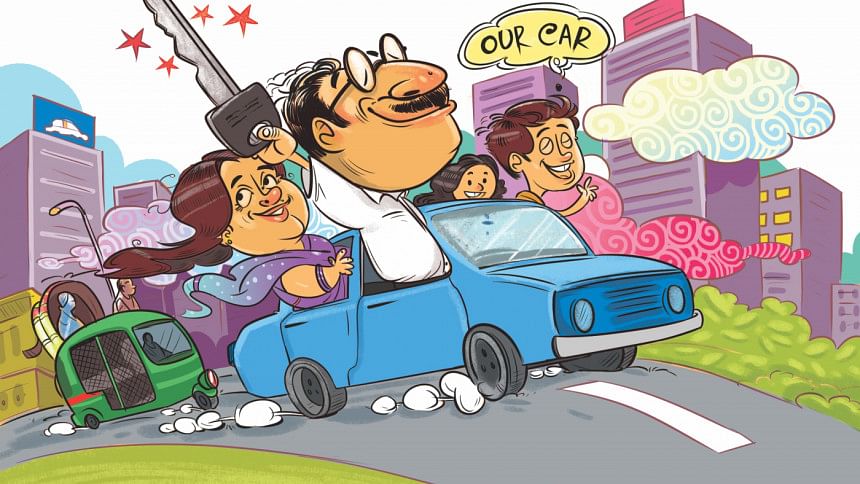Changing tastes in a growing car market

The market for automobiles in Bangladesh, especially the four-wheeler segment, is as small as it is diverse. With brand new car dealerships seeing about 80-90 units go out the doors on the popular end every year and lesser brands selling about 20-30 if they are lucky, Bangladesh's brand new car market is by no means a volume player in the global context. Even with a relatively small market, Bangladesh has the official presence of more than 24 major global brands—including German manufacturers like Mercedes-Benz, BMW, and Audi alongside other European brands such as Volvo and Peugeot—offering full after-sales services, loyalty programmes and more.
For a long time, Bangladesh's automobile industry was dominated by a single brand, Toyota, with much of the brand new and reconditioned markets seeing huge volumes of the Japanese manufacturer's products entering the country. Navana Ltd., the authorised distributor of Toyota vehicles in Bangladesh at present, has been around since 1964. At a time when the local market was awash with American and European options like General Motors, Ford and Volkswagen, Toyota launched the humble-yet-capable RT40 Corona in the local market (then East Pakistan) through a collaboration with Navana Ltd. With strong reliability, fuel efficiency and a much more affordable price, the Corona was a turning point for the region as Japanese cars replaced American and European vehicles.
Since the reconditioned market was opened up and pre-owned cars were allowed to be purchased and shipped to the country in the early 1990's, smaller businesses that did not have the capital or expertise to provide after-sales services, like the official dealerships, eventually caught on. With Toyota having a reputation for reliability and relatively low demand for maintenance, the brand was an easy choice for these reconditioned dealerships to bring in high volumes. With time, alongside growing incomes and greater access to car loans, the market became more diverse and less focused on Toyota. Brands like Honda, Mitsubishi, Nissan and Hyundai catered to car buyers who cared more for style, presence and features over outright reliability. Brands which would never have been considered before, like KIA, suddenly seemed to offer great value for money, especially with Sport Utility Vehicles and Crossovers.
The KIA Sportage was an early hit in a market that would soon become saturated with SUVs and Crossover vehicles. With sub-40 lakh taka pricing in 2010/11, the Sportage offered a tremendous list of features, a high driving position, plenty of space and exterior style to match the increasingly outgoing lifestyles of upper-middle class Bangladeshis. Similarly, the 2013/14 Honda Vezel became a darling of the crossover utility segment—for the first time ever, customers could get the luxury and space of an SUV with the driving dynamics and running costs of a sedan. They flew out of dealerships faster than the dealers could stock them, with the 2015/16 hybrid Vezel versions adding a new option to an already diverse market.
With its success, the reconditioned Honda Vezel actually boosted sales for the brand new market as well. The brand new and reconditioned markets in Bangladesh had never really seen eye-to-eye. Even today, the two camps are decidedly against each other in every way. However, with the popularity of the Honda Vezel among consumers, perceptions about the Honda brand began to change from one of ownership hassles and lack of parts availability to a manufacturer that made cars that are great to drive, packed to the brim with features and fairly easy to maintain if you do some research.
The 2017 Honda Civic—the running generation of Honda's bestselling global model—is a car that would have sat unsold on the DHS Motors showroom floor for years on end if it had been launched into the market in 2010. With a fairly complicated turbocharged 1.5 litre engine, complex electronic features like voice-control and Android Auto/Apple CarPlay navigation and entertainment system, the Civic is as loud with its features as it is with its exterior design and colour options. It is selling so well that a sea of drab silver and white Toyota Corollas are broken up by a red or electric blue Honda Civic more often than you think on Dhaka's roads.
All of this points to a growing class of consumers who are more image conscious than the generations before it. As 30-something year olds become decision makers in their families, they are the ones who are often the driving force behind automotive purchases. With the financial independence a growing class of young individuals are opting for the road-less-travelled and purchasing products that combine style, efficiency and value, despite posing a greater risk of low resale value and ownership/maintenance complications. While the risk-averse older generations might hesitate at the idea of spending more than 30 lakh taka on a potentially risky purchase, it does make the market grow towards a level that can sustain and even justify that purchase.
This trend has even led to the introduction of relatively unknown brands brought in by largely traditional minded local groups. Renault, brought in by Karnaphuli Group, and more recently Morris Garages/MG, brought in by Rancon (a subsidiary of Rangs Group), come to mind. While brands like Toyota and Honda (and on the upper end of the scale, BMW and Mercedes-Benz) have an undeniable foot-hold in terms of brand awareness, Renault and MG are relatively alien names despite being key players in markets in the EU and China, respectively. This shows that even the most traditional mind-sets in the market are finding faith in the new-found zeal with which car buyers are exploring their options.
Even despite the abysmal conditions of Dhaka traffic, the high rates of import and road tax, the relative lack of an after-sales servicing industry that is not attached to a dealership, as well as a widening income gap between income classes, the automobile industry continues to gain ground with each passing year. With time, given a robust policy of regulating the market and incentivising local assembly, the industry can grow even larger.

 For all latest news, follow The Daily Star's Google News channel.
For all latest news, follow The Daily Star's Google News channel. 



Comments